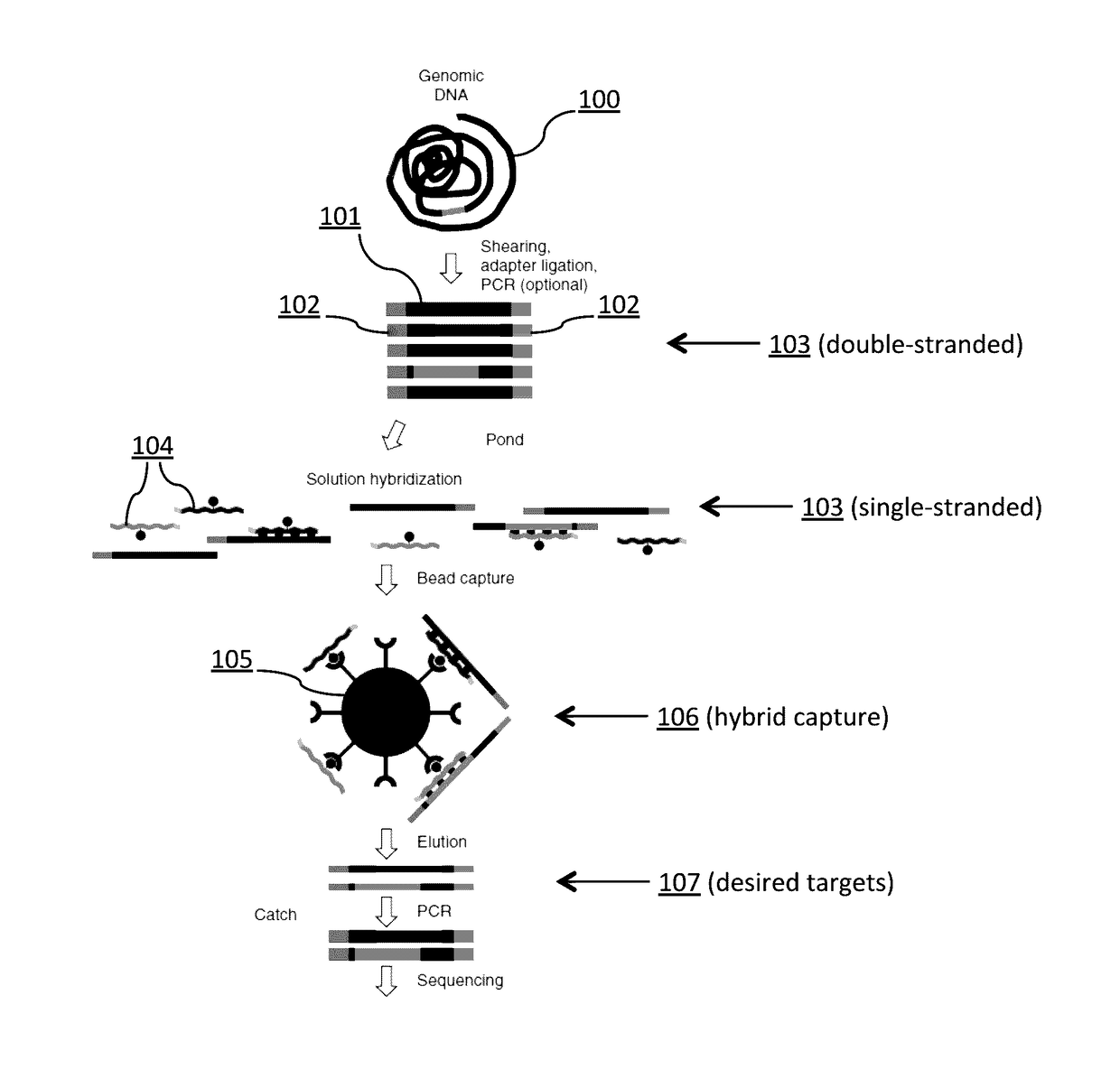Tm-ENHANCED BLOCKING OLIGONUCLEOTIDES AND BAITS FOR IMPROVED TARGET ENRICHMENT AND REDUCED OFF-TARGET SELECTION
a technology of blocking oligonucleotides and targeting oligonucleotides, which is applied in the field of modified oligonucleotide compositions and their use in methods for nucleic acid selection and sequencing, can solve the problems of large fraction of unwanted sequences that are present unwanted ngs templates that are recovered, and large fraction of unwanted sequences that remain in the enriched pool. achieve the effect of enhancing/reducing relative target coverage depth,
- Summary
- Abstract
- Description
- Claims
- Application Information
AI Technical Summary
Benefits of technology
Problems solved by technology
Method used
Image
Examples
example 1
tion of DNA Probe to the Capture Products
[0456]The procedure below summarizes the steps necessary for hybridization of the DNA probe with the capture products.
A. Hybridization
[0457]One hundred nanograms of pooled biotinylated baits, 500 ng of adapted DNA library, 2 μg Cot-1 DNA, 2 ng of oligonucleotide blockers 2.0 μL is combined into a volume of 10 μL and mixed with 10 μL of pre-warmed Genisphere Buffer 6 (2×SDS-Based Hybridization Buffer: 0.50M NaPO4, 1% SDS, 2 mM EDTA, 2×SSC, 4×Denhardt's Solution). Following vortex mixing of the mixture, an overlay of 40 μL mineral oil is applied and the mixture is denatured in a thermocycler at 95° C. for 5 minutes with a slow decrease to 71° C. The mixture is incubated at 71° C. for 48 hours.
B. Binding to Streptavidin Beads
[0458]The streptavidin beads are prepared in the following manner before addition to the hybridization mixture. The streptavidin beads are allowed to sit at room temperature for 30 minutes. For each hybridization reaction, 5...
example 2
ions with Single-Stranded Template Material
A. Final PCR Enrichment
[0462]The recovered single-stranded templates (16 μL) are prepared to a total volume of 50 μL with the following reaction mix components (KAPA HiFi master mix (25 μL); 25 μM Primer 1 (1 μL), 25 μM Primer 2 (1 μL), Water (7 μL)). The DNA is vortexed briefly and recollected as a solution following brief centrifugation. The reactions are placed into a thermocycler with the following program: 98° C. (45 sec); 98° C. (15 sec); 60° C. (30 sec); 72° C. (30 sec); 77° C. (30 sec) for five or more cycles. The amplified products are purified with AMPure beads using 1.5×volume and eluting in 20 μL EB Buffer (Qiagen) (10 mM Tris-HCl, pH 8.5). The resultant concentration of the DNA is measured with a Quibit Fluorometer and diluted for use with the appropriate NGS sequencing platform.
[0463]Five cycles of amplification are used for post-capture Ion Torrent libraries and typically not more than 18 cycles of amplification are used for ...
example a
cid Isolation from a Tumor Sample
[0473]3×20 μm sections cut from a paraffin block were mixed with 400 μL Buffer FTL by vortexing and incubated at 90° C. for 15 minutes in a 1.5 mL centrifuge tube. A range of 88-92° C. was acceptable for the incubation. Then, the sample was incubated with 20 μL proteinase K at 55° C. for 6 hours and 10 μL RNase (1 mg / mL) at room temperature for 5 minutes. Next, 460 Buffer BL and 500 μL absolute ethanol were added to the sample. The resulting sample solution was kept at room temperature until further use.
[0474]To prepare the column for DNA binding, 100 μL Equilibration buffer was added to a MicroElute column and the column was centrifuged at 10,000×g for 30 seconds. 700 μL of the sample solution described above was transferred to the MicroElute column and the column was centrifuged at 10,000×g for 1 minute. The centrifugation step was repeated if fluid did not completely pass through MicroElute column. The remaining sample solution was applied to the ...
PUM
| Property | Measurement | Unit |
|---|---|---|
| Tm | aaaaa | aaaaa |
| nucleic acid melting temperature | aaaaa | aaaaa |
| nucleic acid melting temperature | aaaaa | aaaaa |
Abstract
Description
Claims
Application Information
 Login to View More
Login to View More - R&D
- Intellectual Property
- Life Sciences
- Materials
- Tech Scout
- Unparalleled Data Quality
- Higher Quality Content
- 60% Fewer Hallucinations
Browse by: Latest US Patents, China's latest patents, Technical Efficacy Thesaurus, Application Domain, Technology Topic, Popular Technical Reports.
© 2025 PatSnap. All rights reserved.Legal|Privacy policy|Modern Slavery Act Transparency Statement|Sitemap|About US| Contact US: help@patsnap.com



